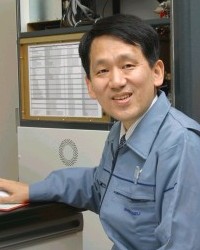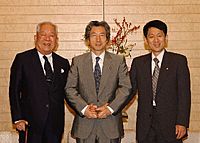Koichi Tanaka facts for kids
Quick facts for kids
Koichi Tanaka
|
|
|---|---|
| 田中 耕一 | |

Koizumi Cabinet E-mail Magazine, No.81, February 6, 2003.
|
|
| Born | 3 August 1959 |
| Nationality | Japanese |
| Alma mater | Tohoku University |
| Known for | Soft laser desorption |
| Awards | Nobel Prize in Chemistry (2002) Order of Culture (2002) Person of Cultural Merit (2002) IEEE Milestone (2024) |
| Scientific career | |
| Fields | Electrical Engineering, chemistry |
| Institutions | Shimadzu Corporation |
Koichi Tanaka (born August 3, 1959) is a Japanese electrical engineer. He won the Nobel Prize in Chemistry in 2002. He shared this award for creating a new way to study large biological molecules. This method uses a technique called mass spectrometry. He shared the prize with John Bennett Fenn and Kurt Wüthrich.
Early Life and Learning
Koichi Tanaka was born in Toyama, Japan. His biological mother passed away shortly after he was born. He studied Electrical Engineering at Tohoku University. He earned his bachelor's degree in 1983. After graduating, he started working at Shimadzu Corporation. There, he helped develop machines called mass spectrometers.
Discovering Soft Laser Desorption
Imagine you want to weigh something incredibly tiny, like a single protein molecule. That's what mass spectrometry helps scientists do. To measure these tiny things, they first need to turn them into a gas and give them an electrical charge. This is often done using a laser.
The problem was that strong lasers would break apart large molecules, like proteins. This made it hard to study them. In 1985, Koichi Tanaka found a clever solution. He discovered that if he mixed the molecules with a special powder made of tiny metal particles in glycerol, the laser wouldn't destroy them. Instead, the molecules would gently turn into a gas and get an electrical charge.
This new method was called soft laser desorption (SLD). It was a big step forward for studying large biological molecules. His discovery was first shared publicly in 1987.
Other scientists, Franz Hillenkamp and Michael Karas, also developed a similar method. Their method, called matrix-assisted laser desorption/ionization (MALDI), used a small organic compound as a mixture. While MALDI was developed earlier, Tanaka's work was important because it showed how to ionize large proteins without breaking them.
Awards and Honors
Koichi Tanaka has received many important awards for his work:
- 1989 – Award of the Mass Spectrometry Society of Japan
- 2002 – Nobel Prize in Chemistry
- 2002 –
 Order of Culture
Order of Culture - 2002 – Person of Cultural Merit
- 2002 – Honorary doctorate from Tohoku University
- 2003 – Honorary citizenship of Toyama Prefecture
- 2003 – Special Award of the Mass Spectrometry Society of Japan
- 2006 – Member of Japan Academy
- 2024 – IEEE Milestone for "LAMS-50K" (he was part of the development team)
See also
 In Spanish: Kōichi Tanaka para niños
In Spanish: Kōichi Tanaka para niños
- History of mass spectrometry
- List of Japanese Nobel laureates


